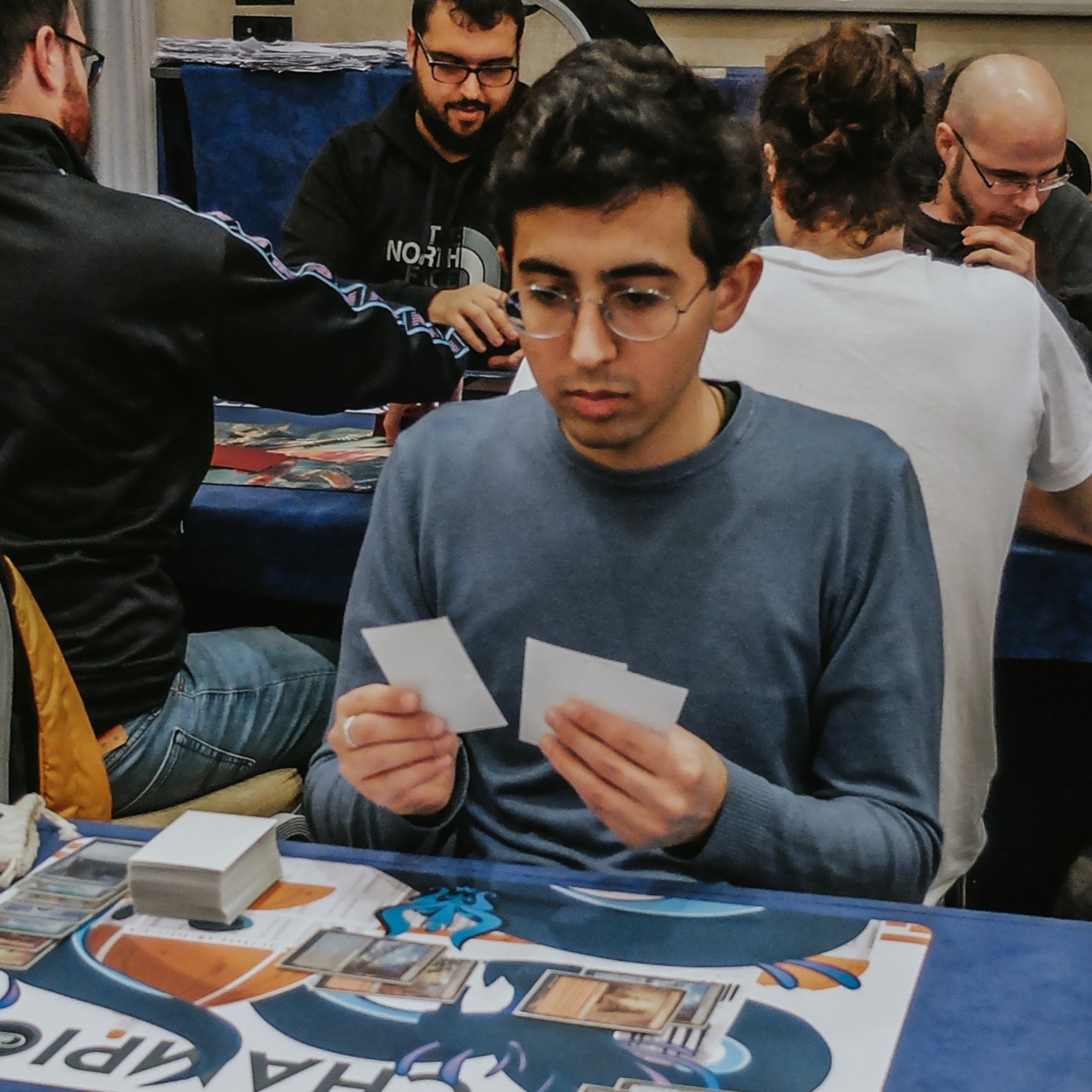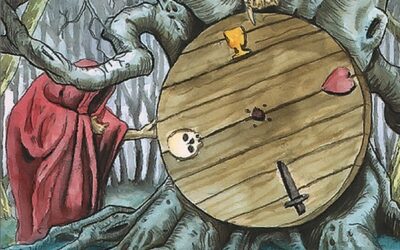Welcome to the fourth and final part of this series of articles, where I show and comment on the data I’ve gathered between Sanctuary’s ban and the release of Commander Masters from my 3452 Pauper matches. If you missed the first, second, and third parts, you should check them out to get familiar with the dataset, but as far as topics go, each part should be fairly independent.
Before getting started, I’ll just remind you that the data that is shown here was collected between Mystic Sanctuary’s ban and the release of Commander Masters.
Up until now, my articles have focused on the performances of decks. Today, I’ll focus on people, trying to shed some light on what kinds of opponents you can face in Pauper. I will also throw in there some other stats just for fun, because when we talk about people it becomes more personal, and we all love some competition and rivalry, don’t we?
Tournaments
Pauper can be played in a variety of environments. The major divide is between online and paper, but inside those two categories, there are also many different kinds of tournaments.
Online you can play leagues whenever you want, or swiss+playoff tournaments like Challenges during the weekend (usually around 60 players), and premiere events on special occasions (usually around 200 players).
On paper, things are more diversified. In my country, Italy, we have weekly swiss-only tournaments at LGSs, swiss+top8 events on the weekend (ranging from 50 to 100 players), team trios (usually around 20 teams), and Paupergeddons (originally around 200 players, nowadays around 500 players).
I will now show a table with my tournament results, to showcase the differences between all these kinds of competitions.
I’m going to point out a few key elements of this chart and leave the rest of its exploration to the reader’s curiosity.
The first thing I notice is the stark difference in the number of games that I’ve played online and in paper. Now, there are certainly people who play in paper more frequently than me, but I doubt that even they can reach my online rate of play, and don’t forget that there are also people who play much more magic Online than me. My point is trivial: paper magic has logistical limitations that don’t allow us to play whenever we want and as much as we want, as opposed to Magic Online. To know a little more about my rate of play, check out the final part of my last article.
Nonetheless, I would say that there is one advantage that paper magic has in terms of match quantity, and it’s in the field of matchup playtesting. If you want to test a specific matchup, it will take tons of league matches to get paired against it enough times, while if you play it with a friend it will be much easier. And yes, targeted testing can also be done on Magic Online, but it’s much more mentally taxing and less fun, which means that people rarely end up doing it online.
Strictly tied to match quantity is my difference in win rate between online and paper play. As much as the European Pauper community keeps growing in quantity and quality, and the environment fostered by the International Pauper League has incentivized tough competition for the most prized titles, it’s undeniable that the average online opponent has played more Magic than the average paper opponent, and is consequently a little harder to beat.
Let’s consider also the fact that the paper win rate should naturally tend to be lower than the online win rate, because of the existence of a third possible match outcome: unintentional draws. Regarding draws, I have to admit that I don’t track them very well on my sheets. Hopefully, I’ve managed to catch all the draws I made for this table. It’s interesting to notice how my draw rate is very high when I play in the local league, while almost nonexistent at more competitive events. When I choose my deck and I’m aiming to win, I make sure to choose a deck that allows me to finish my matches, while at the LGS I’m more liberal with deck choices. But I also think that there is an objective problem with the abundance of draws at my store.
Magic Online Leagues
Leagues are supposed to be the most casual kind of tournament on MtGO, and they probably are. Nonetheless, the level of competition in Pauper leagues is fairly high, because they are populated by grinders, as perceived also by pro player Andrea Mengucci and expressed in a tweet and on video. But how likely are you to face a grinder? Is it quantifiable?
I will try to answer these questions by combining my dataset with the only dataset that I have available on other players: the challenge project. Measuring league players by their challenge success isn’t going to be the perfect way, but in my opinion it’s a good approximation because almost every player who plays competitively on Magic Online participates in challenges, which are the main outlet for high-stakes Pauper.
In the following two charts, I will separate league players into a few categories based on their recorded accomplishments in Pauper challenges. Then, for each category, I will show how much of the league metagame is made by players in that category, based on the data gathered in my 2786 league matches.
In the win rates chart, I’ve only considered win rates from players who have played at least 60 matches in challenges or premiere events. Those who have played less than 60 matches have their own category.
Countries
We all know that the four countries with the biggest online Pauper communities are Brazil, Italy, the USA, and Japan. It isn’t by chance that these countries have a seat in the Pauper Format Panel. I wondered if it was possible to quantify how large these communities are on Magic Online, and I tried my best, although the result leaves much to be desired.
I knew the nationality of my opponent in 34.5% of the league matches I played. The chart you’re about to see shows the distribution of nationalities within this set of matches. There are two main biases that this approach has:
- I only face opponents who play at my same hours.
- I might know more players from certain groups than others.
Just like in the previous section, I will be talking about league meta share, not percentage of players. If a single player plays a lot, they’re going to increase the meta share of their category more than a player who plays less.
Since I had already compiled a list of players by nationality, I couldn’t help asking myself which is the most successful country on Magic Online. Challenge data returned this picture:
Unfortunately, Italy gets a meager third place. Interestingly, the win rate of players from these countries against me would also put them more or less in this order (while being overall lower). Brazilians take Pauper quite seriously.
If your nationality isn’t mentioned here, I’m sorry, but it’s because I don’t know enough challenge players from your country to get enough data.
Individual Challenge Results
The challenge data on players that I’ve been using in this article isn’t directly visible on Castle of Commons, so I will show it here for those who would like to check it out. I’ve only included people who have at least 60 challenge matches tracked in the challenge data between Sanctuary’s ban and Commander Masters release. The table is automatically sorted by Win Rate, but you can sort it by other columns too.
Head-to-Heads
I like checking out head-to-heads in sports. They create narratives and rivalries, making matches more engaging. In Magic, a head-to-head doesn’t tell the whole story about two players, because there are additional factors at play, like matchups. Nonetheless, I figured it would be fun to report my head-to-heads in case you’re curious to see how I fared against you or your favorite Pauper player. The table initially shows at the top the opponents that I have faced the most (i.e. it’s sorted by meta share), but you can sort it in other ways too. If I’ve met a player both online and in real life, they might appear on this table with either their online nickname or their real name, but hopefully they shouldn’t appear with both. I also have to clarify that I usually don’t keep track of my opponent’s name in real life unless I know them in advance, so some opponents from paper tournaments are missing from the table.
Self-Sustaining Hobby?
This last section is dedicated to the financial aspect of tournaments. I’m not interested in the other financial parts of the game, so I won’t touch on them. My Magic Online earnings are reported in the first table of this article. The situation there is pretty simple: cards and tournament fees are the only costs, and prize structures usually allow anybody to go positive even with low win rates. For more details, check out the amazing EV calculator by GoatBots. Challenges and premiere events tend to be way more profitable than leagues, but they require you to spend several hours on a continuative Magic Online session, which makes them harder to attend.
As far as paper Magic goes, your ability to go positive obviously depends on a lot of factors.
- Geography and public transport. I live in a small country, where I can pay 30 euros to hop on a train and comfortably reach another region, and I can spend even less if I take a car with four other people. I’m aware that living in other countries can make travel more expensive. Without taking anything away from LPI’s amazing work, I believe that the ability to travel for cheap is one of the most important preconditions to Paupergeddons’ success.
- Tournaments and prize pools. Some tournaments are high-risk and high-reward, while others have a flatter prize distribution. Some tournaments have expensive venues that take away a lot of money from prizes, while others can convert more entry fees to prize money. Some stores have a good inventory to spend your credit on, while others don’t. And so on.
- Buying habits. Clearly, only buying the cheapest versions of the cards you need is different from buying nice editions of every card in the format. This and other buying habits reflect on the final gain/loss.
- What you consider as profit. A strict approach only looks at the money coming in and out of your own pockets, while a more liberal approach can look at cards as some kind of capital.
I believe that if you pay attention to all these factors and you have an excellent win rate, you can go positive in paper, but ultimately I don’t think that anybody should dream about making money with paper Magic unless they’re interested in the professional scene, on which I lack information. The ability to not care about going positive naturally depends on someone’s economic condition, but personally I find that a healthy approach is to see tournaments as a way to make the hobby affordable.
Here’s a chart with my expenses and earnings relative to paper Pauper. They only cover about half the three-year period that characterized every other part of this article series, simply because I started tracking this kind of data pretty late.
Conclusion
I hope these articles were a fun and/or interesting read. Writing them was much more time-consuming than I initially anticipated, so I will definitely take a break from writing for some weeks at least. But I have many little projects underway, and hopefully I will be able to write about some of them as well in the future.








![[ENG Report] Winner Awesome Pauper – Il Labirinto: Francesco Quagliata with Golgari Gardens](https://www.pauperwave.com/wp-content/uploads/2024/01/215-400x250.jpg)


